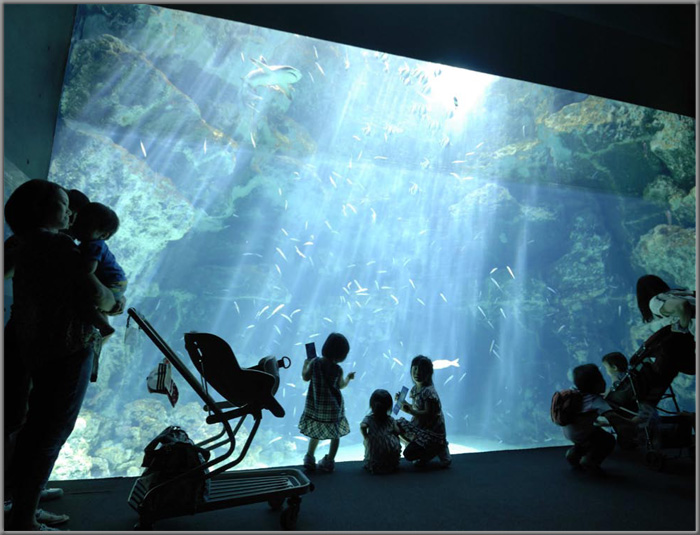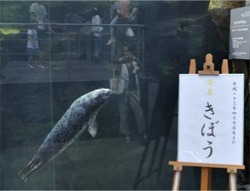Home > Highlighting JAPAN > Highlighting Japan SEPTEMBER 2011 > Aquarium Brings Hope to the People
Highlighting JAPAN
COVER STORY: A Rousing Summer in Tohoku
Caption: Aquamarine Fukushima's huge fish tanks hold all kinds of fish, from shark to yellowfin tuna, all exhibited under natural light.
Credit: YOSHIFUSA HASHIZUME
Aquarium Brings Hope to the People

Harbor seal cub Kibo swims in front of a sign bearing his name. "Kibo" means "hope."
Credit: YOSHIFUSA HASHIZUME
Aquamarine Fukushima was severely damaged by the Great East Japan Earthquake. Measuring a magnitude 9.0, the quake caused the ground in the surrounding landfill area to collapse almost one meter, and the water conduits and all other pipework burst. The basement was submerged by a 5-meter tsunami, totally destroying the electrical system, which was the lifeline of the aquarium. As a result, over 90% of the aquarium's 200,000 aquatic animals belonging to 750 species perished.
"Restoration work began with the director declaring that the aquarium would reopen on July 15, the 11th anniversary of its first opening. It was the end of April, when the entire staff returned to the site. To be honest, I thought it was impossible," reflects Jun Tsuzaki, head of the breeding management section. "But as we continued with the work, I began to think that reopening would help cheer up the local people, which in turn would vitalize the region and encourage other facilities to work hard to restart their operations too. It was really satisfying work."
Tsuzaki began the serious reconstruction work from mid-May, when the debris removal work had been completed by his staff, and after a mere two months the facility reopened as planned on July 15. The radioactivity level is not a problem at all in this area. Donations arrived from aquariums all over the world, and support was received from more than twenty aquariums in Japan, including temporary homes for marine animals as well as supplies of fish. For example, immediately after the earthquake harbor seals and walruses were taken in temporarily by Kamogawa Sea World in Chiba Prefecture. A male harbor seal cub born there was named "Kibo" (meaning "Hope"), and is now a popular attraction at Aquamarine Fukushima.
With visitor numbers topping 900,000 people each year, Aquamarine Fukushima endeavors to be creative in its exhibition style, reproducing as faithfully as possible natural habitats under the overall theme of "Educating about Life." One of its main distinguishing features is that it exhibits not only fish but a variety of plants, seaweed, and invertebrates as well under natural light. The aquarium's unique operational style, such as the exhibition facility for children named "Aquamarine Egg," and its activities to promote understanding in respect of environmental conservation, is held in high repute around the world.
"The question is how to evolve these characteristics of Aquamarine Fukushima. I do not want simply to restore it to its original form. Rather, I would like to make it a display that is even more wonderful than it was before," says Tsuzaki.
A family of four who had come by car from Sendai, Miyagi Prefecture, proudly showed the fish they had caught at the outdoor artificial beach, saying, "We were able to get all kinds of hands-on experience. It's a fantastic aquarium, and we're really glad that it opened so quickly."
| Access • Approximately 1 hour 40 minutes by car from Fukushima Airport on National Highway No. 49 • Approximately 2 hours on the JR Joban Line from Ueno Station to Izumi Station. Approximately 15 minutes from Izumi Station by shuttle bus to the nearest bus stop, Shisho Iriguchi, then approximately 10 minutes' walk. |
© 2009 Cabinet Office, Government of Japan






